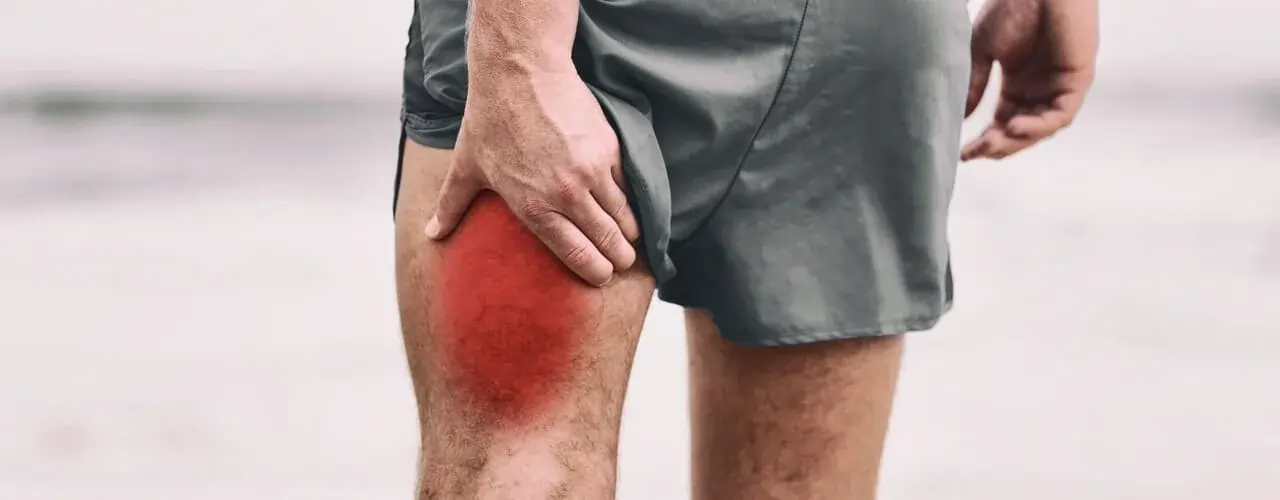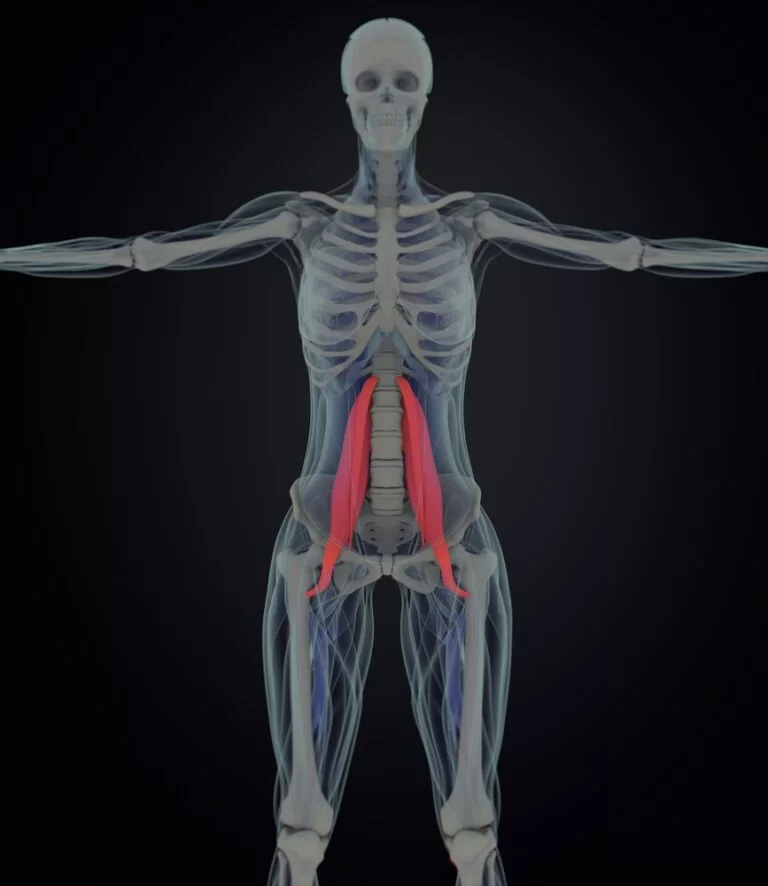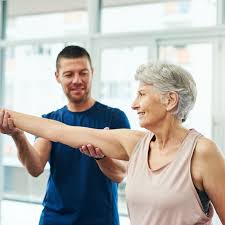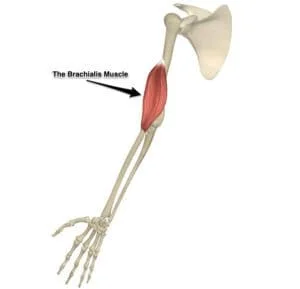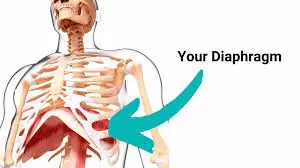Hamstring muscle pull
Table of Contents
What is hamstring muscle pull?
A hamstring muscle pull also called a hamstring strain occurs when one or more of these muscles gets over-stretched and leads to tear. Hamstring strains can be mild, with less pain and related symptom’s and short recovery time. Or, they can be moderate to severe and need surgery and require rest and supports for few weeks.
Hamstring muscle pull are most common sports injury and seen athletes of all forms eg. runners, skaters, football, soccer, cricketers and basketball players.
Hamstring muscle pull occurs when one or more of these muscles gets overstretched. The muscles might even start to tear. You’re likely to get a hamstring pull during activities that involve a lot of jerky movement of knee – running & jumping or sudden stopping & starting.
Anatomy of Hamstring muscle:
Hamstring muscle is one of the 3 posterior thigh muscles in between the hip & the knee (from medial to lateral:
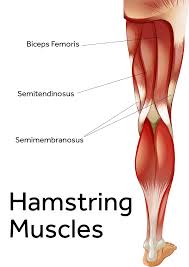
- Semimembranosus
- Semitendinosus
- Biceps femoris
- The hamstrings are quite susceptible to injury.
- A hamstring strain is a common leg injury involving a tear in one or more of the hamstring muscles.
- A hamstring strain can range from mild to very severe involving a complete tear of the hamstring muscle.
- You have four hamstring muscles: semimembranosus and semitendinosus (medially) and biceps femoris – short and long heads (laterally).
Biceps Femoris:
Origin: Ischial tuberosity
Insertion: The fibular head and lateral condyle of the tibia
Function: Knee flexion, lateral rotation of the tibia, and hip extension
Innervation: Tibial nerve
Vascular supply: Perforating branches of the deep femoral artery
Semitendinosus
Origin: Lower, medial surface of the ischial tuberosity
Insertion: Medial tibia (pes anserinus)
Action: Flexion of the knee joint, Extension of hip joint, & Medial rotation of the tibia (with knee flexion)
Innervation: Tibial nerve
Blood supply: Perforating branches of the deep femoral artery
Semimembranosus
The semimembranosus muscle is flattened and broad. It is located underneath the semitendinosus.
Origin: Ischial tuberosity
Insertion: Medial tibial condyle
Function: Flexion of the knee joint,Extension of hip joint, and Medially rotates the thigh at the hip joint and the leg at the knee joint.
Nerve supply: Tibial nerve
Blood supply: Perforating branches of the deep femoral artery
What causes hamstring muscle pull?
- Common reasons for hamstring muscle pull or injury can be categorized as primary or secondary.
- As a group, they are known as the hamstring. A hamstring muscle pulled , sometimes called a hamstring strain, happens when one or more of these muscles gets stretched too far and starts to tear.
- Hamstring muscle pull can be mild, with little pain and a short recovery time. Or, they can be severe and need surgery and crutches for weeks.
- A hamstring muscle pull generally occurs as a result of muscle overload, such as when you are running and your leg is fully stretched out just before your foot strikes the ground.
- When your foot strikes the ground and all your weight is on it, the muscles can get stretched too far and they may start to tear.
- People who take part in certain activities that involve sprinting or jumping (like track and field, soccer, football, lacrosse, basketball, and dance) are more at risk of getting hamstring muscle pull.
- These kinds of injuries are also more common in teens who are going through growth spurts.
- That’s because the leg bones may grow faster than a person’s muscles, pulling the muscles tight and leaving them more susceptible to getting stretched too far.
Some of the more common things that can contribute to a hamstring muscle pull include:
- Not warming up properly before exercising : -Tight muscles are much more likely to strain than muscles that are kept strong and flexible.
- Being out of shape or overdoing it: -Weak muscles are less able to handle the stress of exercise, and muscles that are tired lose some of their ability to absorb energy, making them more likely to get injured.
- An imbalance in the size of your leg muscles: -The quadriceps, the muscles at the front of your legs, is often larger and more powerful than your hamstring muscles.
- When you do an activity that involves running, the hamstring muscles can get tired more quickly than the quadriceps, putting them at greater risk of a hamstring pull.
- Poor technique: -If you don’t have a good running technique, it can increase the stress on your hamstring muscles. -Returning to activities too quickly after an injury. -Hamstring muscle pull need plenty of time and rest to heal completely. -Trying to come back from a strain too soon will make you more likely to injure your hamstring again.
Primary
- Poor timing-inter muscular coordination and eccentric strength in the hamstring muscles during the switch between late leg recovery and initial leg approach in the swing phase of sprinting.
- Lack of “stiffness” and eccentric strength in the hamstring muscles during the ground contact phase of running.
- “Stiffness” refers to the ability of the hamstring muscle to absorb shock and rebound.
- Dropping a golf ball onto concrete is an example of stiffness, it immediately rebounds off the surface.
- Previous hamstring muscle pull is a very good indicator of potential for future injury.
Secondary
- Poor running mechanics. -This consists primarily of over-striding or poor pelvic control, which puts the hamstrings in a vulnerable position at ground contact.
- Improper warm-up. -Your warm-up must be active and dynamic to prepare the hamstring muscles for the forces involved. –
- Passive stretching is only one segment of warm-up.
- Inappropriate training loads. -Your hamstrings are primarily fast twitch Type II fibers that fatigue quickly.
- High-speed work should be done early in the workout, as close to warm-up as possible to avoid fatigue.
- Fatigue (neural and local muscle).
- Lower back pathology. -Abnormalities of the lumbar spine or poor pelvic control that can cause nerve dysfunction and subsequent muscle weakness can predispose you to injury.
- Playing surfaces. -A wet slippery surface will put more strain on the hamstring due to slipping.
What are the Risk factor of hamstring muscle pulled ?
There are various risk factors which may play a role in hamstring injuries:
- Older age
- Previous calf injury
- Previous hamstring injury
- Limited hamstring flexibility
- Increased fatigue
- Ethnicity
- Previous substantial knee injury
- Ethnicity
- Poor core stability
- Strength imbalance
- Ethnicity
- Osteitis pubis
- Improve quadriceps flexibility was inversely associated with hamstring strain.
- Players presenting certain polymorphism, IGF2 and CCL2 (specifically its allelic form GG), might be more vulnerable to severe injuries & might be involved in specific prevention programs.
- Tight hip flexors
- previously associated lumbar spine abnormalities. Kicking & executing abdominal strengthening exercises with straight legs have been identified as possible contributory causes of lordosis. The anatomical reason seems to be that the iliopsoas muscle group is primarily involved in kicking & straight leg raising or straight leg sit-up exercises & contributes to strengthening this muscle’. Therefore, it is possible that certain athletic activities & training methods that exacerbate postural defects may also predispose the player to injury.
- During activities like running & kicking, hamstring will lengthen with concurrent hip flexion & knee extension, this lengthening may reach the mechanical limits of the muscle or lead to the accumulation of microscopic muscle damage. There is a probability that hamstring injuries may arise secondary to the potential uncoordinated contraction of biceps femoris muscle resulting from dual nerve supply.
- Another debate is on hamstring variation in muscle architecture. The short head of biceps femoris(BFS) possesses longer fascicles (which allow for greater muscle extensibility & reduce the risk of over lengthening during eccentric contraction) & a much smaller cross-section area compared to the long head of biceps femoris(BFL). Whereas BFL presents with shorter fascicles compared to BFS which undergo repetitive over lengthening and accumulated muscle damage.
- Excessive anterior pelvic tilt will place the hamstring muscle group at longer lengths & some studies proposed that this may increase the risk of strain injury.
What are the Symptoms of a Hamstring muscle pulled?
- Mild hamstring strains may feel more like a tightness or low-grade ache in your hamstring.
- Severe hamstring strains can be extremely painful, making it impossible to walk or even stand.
Other possible symptoms of a hamstring strain are:
- Sudden and severe pain during exercise, along with a snapping or popping feeling.
- Pain in the back of the thigh and lower buttock when walking, straightening the leg, or bending over.
- Hamstring tenderness.
- Bruising.
How is a Hamstring muscle pulled Diagnosed?
- On examination, your physiotherapist or sports doctor will look for signs of pain on hamstring contraction, reduced hamstring flexibility, tenderness or a palpable lump or gap within the hamstring muscle bulk.
- Pulled hamstrings are graded 1, 2 or 3 depending on severity.
- Ultrasound scan and MRI are able to identify the location and extent of your hamstring tear.
Hamstring muscle pulled Grade 1 [mild Hamstring pull]
- With a grade 1 hamstring muscle pull, you may have pain and tenderness in the back of the thigh but will be able to walk normally.
- You will be aware of some hamstring discomfort and unable to run at full speed.
- There will be mild swelling and spasm.
- Bend your knee against resistance is unlikely to reproduce much pain.
Hamstring muscle pulled Grade 2 [partial Hamstring muscle pulled ]
- With a grade 2 hamstring muscle pulled , your walking pattern will be affected and you will most likely be limping.
- Sudden twinges of hamstring pain during activity will be present.
- You may notice some hamstring muscle swelling and your hamstring will be tender to palpate.
- It will also be painful for you to bend your knee against resistance.
Grade 3 [complete Hamstring muscle pulled ]
- A grade 3 hamstring muscle pulled is a severe injury involving a tear to half or all of the hamstring muscle.
- You may need crutches to walk and will feel severe pain and weakness in the muscle.
- Swelling will be noticed immediately and bruising will usually appear within 24 hours.
- may have a ”popping” sensation at the time of injury and unable to use affected leg.
Diagnostic MRI may also be used to specifically identify the grade of hamstring tear and its exact location.
Differential Diagnosis of hamstring muscle pull.
- On examination the patient, the physiotherapist possibly has to differentiate between different injuries e.g.
- Adductor strains, avulsion injury, lumbosacral referred pain syndrome, piriformis syndrome, sacroiliac dysfunction, sciatica, Hamstring tendinitis & ischial bursitis.
- Other sources of posterior thigh pain could also be confused with hamstring muscle pull & should be considered during the examination process. Specific tests & imaging are used to assess & exclude those different pain source possibilities.
- Sciatic nerve mobility limitations can contribute to posterior thigh pain & adverse neural tension could in some cases be the only source of pain without any particular muscular injury. In some cases it is difficult to determinate whether it is the Hamstrings or other muscle groups like hip adductors (eg. M. Gracilis and M. Adductor Magnus & Longus.) that are injured due to their proximities. Manytimes imaging procedures may be required to determinate the exact location of the injury.
- Other conditions with same presentations as hamstring muscle pull are strained popliteus muscle, tendonitis at either origin of the gastrocnemius, sprained posterior cruciate ligament, astrophysicist-pain in ischial tuberosity, Lumbar spine disorders & lesions of the upper tibiofibular joint.
Beware of Referred Hamstring Pain!
- Due to your sciatic nerve passing through the hamstring muscle group, a lower back injury or some other injury that pinches the sciatic nerve can replicate the symptoms.
- It is therefore vital that you seek a professional diagnosis from an expert in hamstring and back injuries.
- The good news is that only the most severe muscle tears require surgery. Most hamstring strains will heal on their own or with some physical therapy.
How Can You Prevent a Hamstring Muscle Pulled?
Keeping your muscles in good shape is the best way to prevent hamstring injuries. Here are some ways to help protect yourself against them (and other sports injuries!):
- Warm up properly before exercise or intense physical activity.
- Jog in place for a minute or two, or do some jumping jacks to get your muscles going.
- Then do some dynamic stretching — ask your coach or an athletic trainer to show you how. After you play, do some static stretches where you gently stretch your muscles, holding each stretch for 30 seconds or more.
- Keep your muscles strong and flexible year-round.
- Get regular exercise and adopt a good stretching program so your muscles don’t get a shock when you do an intense workout.
- Increase the duration and intensity of your exercise slowly.
- A good rule of thumb is to make sure you add no more than 10% each week to the miles you run or the time you spend playing a sport.
- If you feel pain in your thigh, stop your activity immediately.
- If you’re worried that you might have strained your hamstring, give it time to rest and don’t go back to your activity until your leg feels strong, you have no pain, and you can move your injured leg as freely as the other one.
How to heal hamstring muscle pull fast?
- To heal hamstring muscle pull fast following tips are useful :
- The goal of any treatment — nonsurgical or surgical — is to help you return to all the activities you enjoy. Following your doctor’s treatment plan will restore your abilities faster, and help you prevent further problems in the future.
Nonsurgical Treatment:
- Most hamstring muscle pull heal very well with simple, nonsurgical treatment.
- Use the RICE principle as soon as possible after the injury:
Rest : Limit the amount of walking you do, and try to avoid putting weight on your leg if your doctor recommends this.
use crutches to avoid putting weight on your leg.
ice : Use a bag of ice or a cold compress to help reduce swelling for the first 48 hours after the injury.
This should begin as soon as possible after the injury and then every 3 to 4 hours for 20 to 30 minutes at a time until the swelling is gone.
Wrap the ice or ice pack in a towel.
Don’t put ice or ice packs directly on the skin because it can cause tissue damage.
Compress : Use elastic bandages or sports wraps to help support your leg and keep the swelling down if your doctor recommends doing so.
Doctors recommend using elastic compression bandages instead of compression shorts because you can adjust the bandages as needed.
Elevate : When you are sitting or lying down, keep your leg elevated.
leg should higher than your heart while resting.
Immobilization : Your doctor may recommend you wear a knee splint for a brief time.
This will keep your leg in a neutral position to help it heal.
Medical treatment :
- Ibuprofen and other non-steroidal anti-inflammatory drugs (NSAIDs) can help relieve pain and reduce swelling in the leg. Some doctors prefer other medicines like acetaminophen.
- Talk with your doctor about what you should take.
- Do stretching and strengthening exercises.
- Slowly adding some exercises can help to improve your leg’s strength and flexibility (and, perhaps, prevent the injury from happening again).
- A doctor, athletic trainer, or physical therapist can help determine when your hamstring is ready for these exercises.
- If you have a complete tear of one of your hamstring muscles or tendons, your doctor might want you to have surgery to reattach the tendon to the bone or fix the tendon.
Surgical Treatment
- Surgery is most often performed for tendon avulsion injuries, where the tendon has pulled completely away from the bone.
- Tears from the pelvis (proximal tendon avulsions) are more common than tears from the shinbone (distal tendon avulsions).
- Surgery may also be needed to repair a complete tear within the muscle.
Procedure:
- To repair a tendon avulsion, your surgeon must pull the hamstring muscle back into place and remove any scar tissue.
- Then the tendon is reattached to the bone using large stitches or staples.
- A complete tear within the muscle is sewn back together using stitches.
- Not overdoing things is key when it comes to this type of injury.
- Many people have a hamstring strain come back because they returned to play too quickly.
- So follow your doctor’s advice and don’t push yourself or feel pressure to get back into sports or other activities .
Physiotherapy treatment of Hamstring muscle pull
Rehabilitation exercise:
Systematic Physiotherapy treatment plan and exercise are helpful in Rehabilitation of Hamstring injury.
- After surgery, you will need to keep weight off of your leg to protect the repair.
- In addition to using crutches, you may need a brace that keeps your hamstring in a relaxed position.
- How long you will need these aids will depend on the type of injury you have.
- Your physiotherapy program will begin with gentle stretches to improve flexibility and range of motion.
- Strengthening exercises will gradually be added to your plan.
- Place your foot on a low table or a chair, and stretch forward from the hip into a comfortable, relaxed position with a gentle stretch at the back of your leg.
- Lie on your back and lift your leg vertically, or as high as is comfortable and Gently pull back on your thigh with your hands, with your knee slightly bent.
- If you can stretch without pain, begin additional exercises to get your muscles back to full strength.
- you should consult a doctor to learn which exercises will focus on your injured muscle with minimal risk of damage.
- If you do not have access to a doctor, try the following once every one to two days, but stop immediately if you experience pain:
- Lie on your back and bring your knee up to a slight angle.
- Contract your thigh muscle with about 50% of its maximum force, hold for thirty seconds, then relax and repeat several times.
- If still pain-free, repeat with your knee at a narrower angle, bringing your foot back up toward your hip.
- Sit on wheeled chair or stool and place both heels on the floor, flexing your hamstrings to pull yourself forward. After a few days of this, try using just the heel of the injured leg.
Rehabilitation for a proximal hamstring reattachment:

- Typically takes at least 6 months, due to the severity of the injury.
Rehabilitation for a Distal hamstring reattachment:
- Require approximately 3 months of rehabilitation before returning to athletic activities.
- Your doctor will tell you when it is safe to return to sports.
Recovery :
- Most people who injure their hamstrings will recover full function after completing a rehabilitation plan.
- Early treatment with a plan that includes the RICE protocol and physical therapy has been shown to result in better function and quicker return to sports.
- To prevent re-injuring your hamstring, be sure to follow your doctor’s treatment plan.
- Return to sports only after your doctor has given you the go-ahead.
- Re-injuring your hamstring increases your risk of permanent damage.
- This can result in a chronic condition.
New Developments For Injury Management :
- Platelet-rich plasma (PRP) is currently being investigated for its effectiveness in speeding the healing of hamstring muscle injuries.
- PRP is a preparation developed from a patient’s own blood.
- It contains a high concentration of proteins called growth factors that are very important in the healing of injuries.
- However, this method is still under investigation and more research is necessary to prove PRP’s effectiveness.
Switch to hot/cold treatment :
- At this point, instead of icing the injury, you can apply a hot pack for 3 minutes, then a cold pack for 1 minute.
- Repeat this six times, for a total of 24 minutes.
- Perform this treatment twice a day until your leg is recovered enough to jog for five minutes without pain.
- Be aware that this treatment is not completely understood, and some doctors prefer to switch entirely to hot treatments.
- In general, cold treatment reduces blood flow, while heat increases it. Increased blood flow encourages healing but also increases swelling, so heat should not be used while the injury is still painful and significantly swollen.
Electrotherapy
- Can be applied after 24 hours, for the first week.
- At the same time, ice treatment should be continued.
- Then, from the second week, alternate heat and cold should be introduced.
- Heat encourages bleeding so it should not be used in the early stages.
- However, at later stages, it will encourage blood flow and healing.
- Heat also helps with muscle relaxation, which in turn can help with pain relief.
- Heat wheat packs are ideal for home use.
Following suggestions will be helpful :
- Completely rehabilitate a hamstring injury before returning to activity.
- Always include a general warm up, followed by an activity specific warm up before training and especially competition.
- Cool down thoroughly after training and competition.
- Include an eccentric strength training program (muscle contraction and lengthening at the same time) for the hamstrings.
- Practice balance, agility and proprioception drills to improve knee and hip stability.
- Reduce the frequency of, or stopping completely, any activities that aggravate the hamstring.
- Rest in between training sessions or competition allows the body to heal minor injuries and repair the muscles to be ready for the next round of activity.
Stretching exercise of hamstring muscle

1.Hamstring muscle stretch:
- Sit on the ground with both legs are out straight.
- Extend the arms & reach forward by bending at the waist as far as possible while keeping the knees straight.
- Hold this position for 15-30 seconds.
- Relax back into the starting position.
- Repeat three times.
Be sure to stretch until a moderate pull is felt in the back of the thighs. If you are feel any excessive pain, you might be stop the exercise.
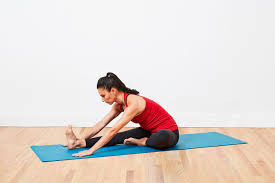
2.Hurdler hamstring muscle stretch:
- Sit on the ground with one leg are out straight.
- Bend the other leg at the knee & position the sole of that foot against the opposite inner thigh.
- Extend the arms & reach forward over the one straight leg by bending at the waist as far as possible.
- Hold this position for 15 seconds.
- Relax and than Repeat with the other leg.
3. Standing hamstring muscle stretch( Both legs are together):
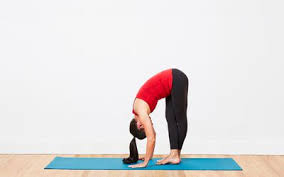
This hamstring stretch is a simple one to do anywhere at the all. It is done in the standing position & stretches both legs at once. Here is how you to do the standing hamstring stretch:
- Stand & cross the right foot in front of the left.
- Slowly lower the forehead to the right knee joint by bending at the waist.
- Keep the both knees straight.
- Hold this position for 15-30 seconds.
- Relax and then Repeat for the other side by crossing the left foot in front of the right.
4. Standing hamstring muscle stretch (one leg at a time)
The one-legged standing hamstring stretch is completely possibly the easiest hamstring stretch to do. It can be done anywhere home, office, or outdoors & it requires no special tools.

- Stand up the straight with one heel resting on a small stool. if it is outside, one can use the curb, but be sure to watch for cars.
- Keep the knee straight.
- Reach both arms up toward the place where the wall & ceiling meet. If outside where there is no wall and ceiling, when simply reach up into the air so that the arms are about even with the ears. Reaching the arms up and as opposed to reaching down toward the foot, will keep the back straight.
- Keep the back straight & One should be bending forward slightly from the hips.
- Reach the forward & feel a stretch in the hamstring behind the thigh.
- Hold this position for 15-30 seconds, & repeat 3 times.
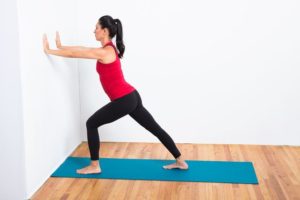
5. Runner’s hamstring stretch
The runner’s stretch is a common flexibility exercise for hamstrings
- Stand one foot from a wall & place the hands on the wall at shoulder height, shoulder width apart.
- Take a step back with 1 leg while pushing into the wall
- Keep the back straight & press the heels into the floor.
- Hold for 15-30 seconds.
- Step forward and the repeat with the other leg.
- Repeat the exercise 3 times on each side.
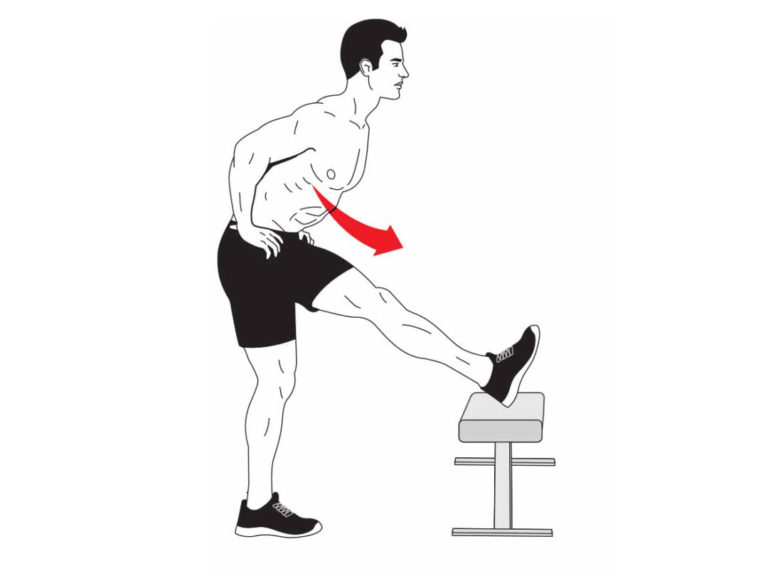
6. Hamstring stretching exercise:
- Place your right foot on a bench or secure chair.
- Your right leg should be completely straight.
- Your left leg should be slightly bent.
- Stand tall with your back naturally arched.
- Place your hands on your hips.
- Without rounding your lower back, bend at the hips and lower your torso until you feel a comfortable stretch.
- Hold the stretch for 30 seconds on each side, then repeat two times.
- Do the routine up to three times a day if you’re really tight.
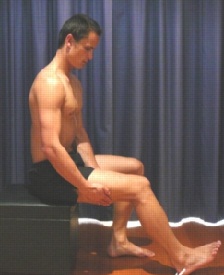
Strengthening exercise of hamstrings muscle:
1.Static Hamstring contraction
- Start this exercise in sitting with the knee bent to about 45 degrees.
- Press the heel into the ground tightening the back of thigh.
- Hold for 5 seconds & repeat 10 times as hard as possible pain free.

2. Bridging exercise
- Start this exercise lying on the back in the supine position.
- Gradually, lift the bottom pushing through feet, until the knees, hips & shoulders are in a straight line.
- Tighten the back of the thigh while performing this exercise.
- Hold for 3-5 seconds then slowly lower the bottom of the back down.
- Perform this exercise 3 sets of 10 repetitions provided the exercise is pain free.
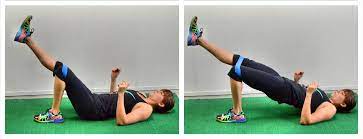
3. Single leg bridging
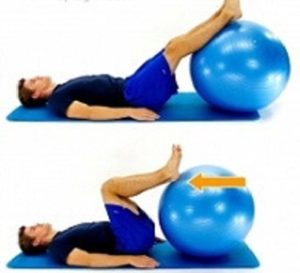
- Lie flat on the back with the knees bent & feet flat on the floor. The feet & knees might be hip distance apart.
- Tighten the abdominal muscles slightly to engage the core and stabilise the lower back.
- Lift up into simple bridge position but as one hold the bridge position, lift 1 foot off the floor & extend the knee as shown.
- Hold for 3-5 seconds, bring the foot back down, & then lower the buttocks to the floor.
4. Hamstring curls with gym ball:
- Lies on the back with the feet & lower calves resting on a gym ball with knees straight & arms crossed over the chest.
- Slowly curl the ball towards the body by bending the knees & then slowly roll the ball away.
- Repeat this exercise for 10 times.
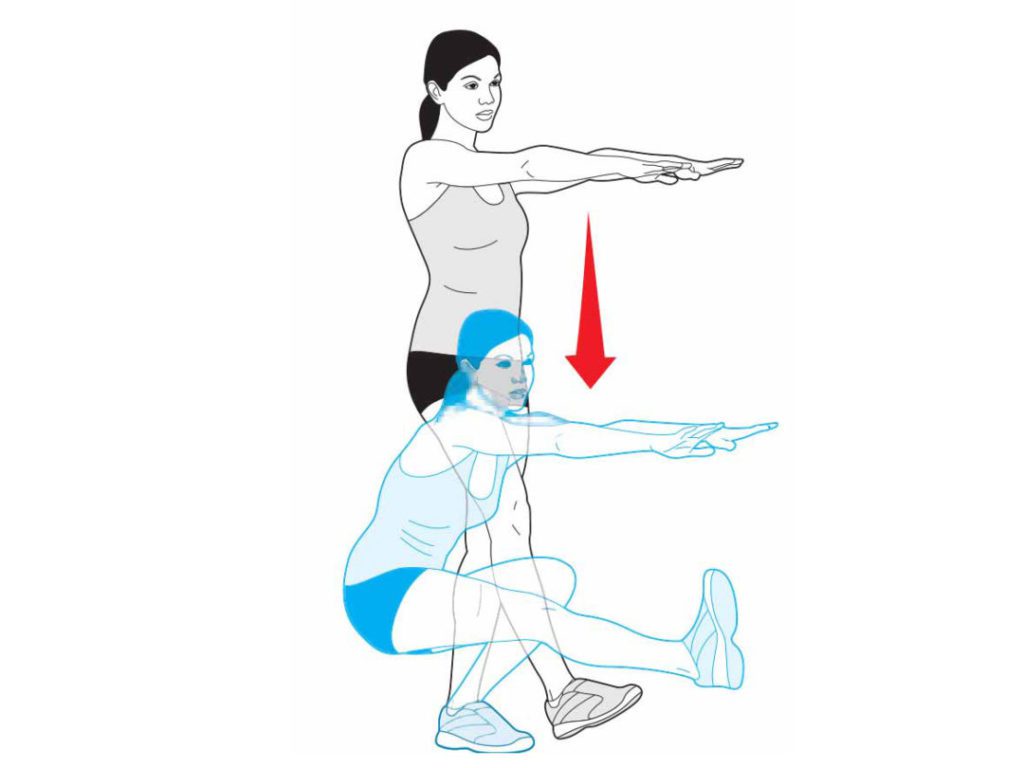
5. Pistol Squat (With Optional Plyo):
- Stand holding your arms straight out in front of your body.
- Raise your right leg off the floor in front of you.
- Keeping your right leg straight, push your hips back and lower your body as far as you can without breaking form.
- As you do this, raise your right leg so that it doesn’t touch the floor, and keep your torso as upright as possible. Pause, then push your body back to the starting position.
- Do equal reps for each leg. For a bigger challenge, as you rise out of the squat, add in a jump off your planted leg.
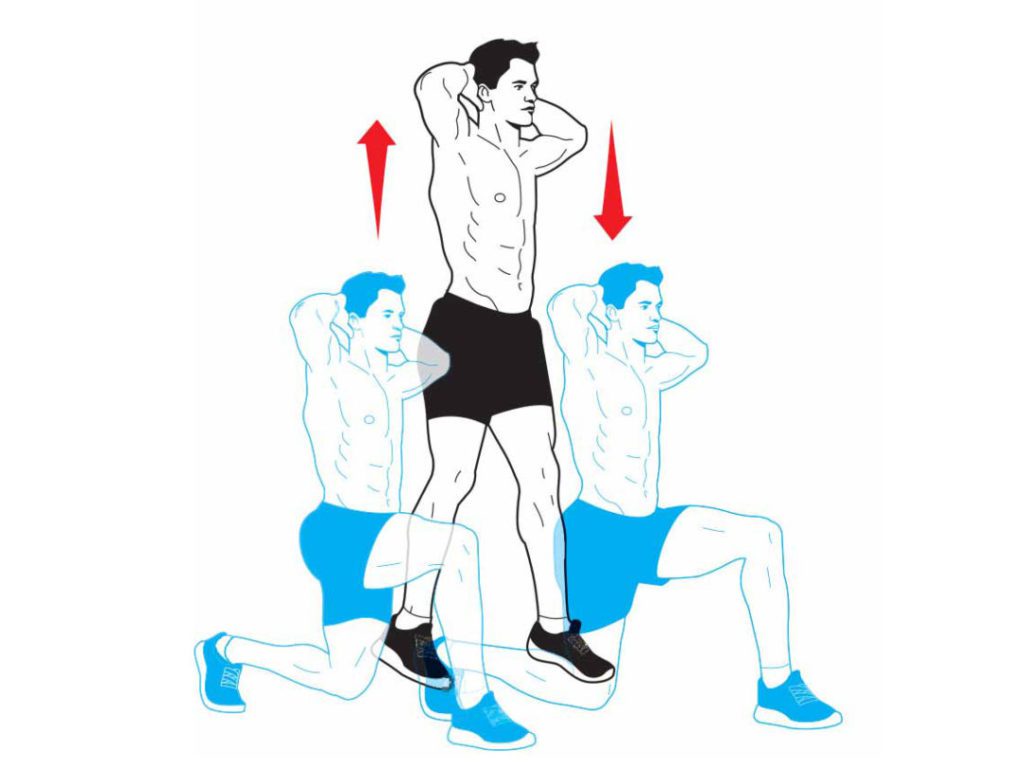
6. Split Jumps (With Or Without Dumbbells) :
- Stand in a staggered stance, your right foot in front of your left.
- Lower your body as far as you can.
- Quickly switch directions and jump with enough force to propel both feet off the floor.
- While in the air, scissor-kick your legs so you land with the opposite leg forward. Repeat, alternating back and forth with each repetition.
7. Glutes Roll

- Sit on a foam roller with it positioned on the back of your right thigh, just below your glutes.
- Cross your right leg over the front of your left thigh.
- Put your hands flat on the floor for support.
- Roll your body forward until the roller reaches your lower back.
- Then roll back and forth. Repeat with the roller under your left thigh.

Hamstring muscle pull kt tape:
- Lack of use, particularly if splinting, results in muscle shrinkage and the formation of scar tissue where the tear is healing.
- Excessive scar tissue prevents healthy muscle function, as it doesn’t stretch and move as normal muscle does.
To avoid these complications rehabilitation exercises need to begin early (except grade III injuries):
- After a few days, once the pain has subsided, you should start to do regular gentle hamstring stretches followed by a program of gentle exercise, such as walking and cycling.
- Always warm up before exercising and cool down afterwards.
- Stop if pain returns.
- To avoid injuring yourself again, you should only return to a full level of activity when your hamstring muscles are strong enough.
Your physiotherapist or sports therapist will be able to advise you on returning to your sport and on a suitable graded exercise program, which might include:
- Starting with decline treadmill running.
- Moving to steep decline treadmill running.
- Doing hamstring strengthening exercises using a pulley system to reduce the load.
- Doing regular hamstring exercises.
- When strength has returned, a gradual return to the desired sport can be attempted.
- Running should be re-introduced gradually.
- Full return is usually possible only after maximal flexibility and strength have been obtained.
- Re-injury is extremely common. Athletes are highly motivated and are likely to have set personal goals for training, timing and performance. However, re-injury not only prolongs recovery, it also increases the risk of permanent damage.

